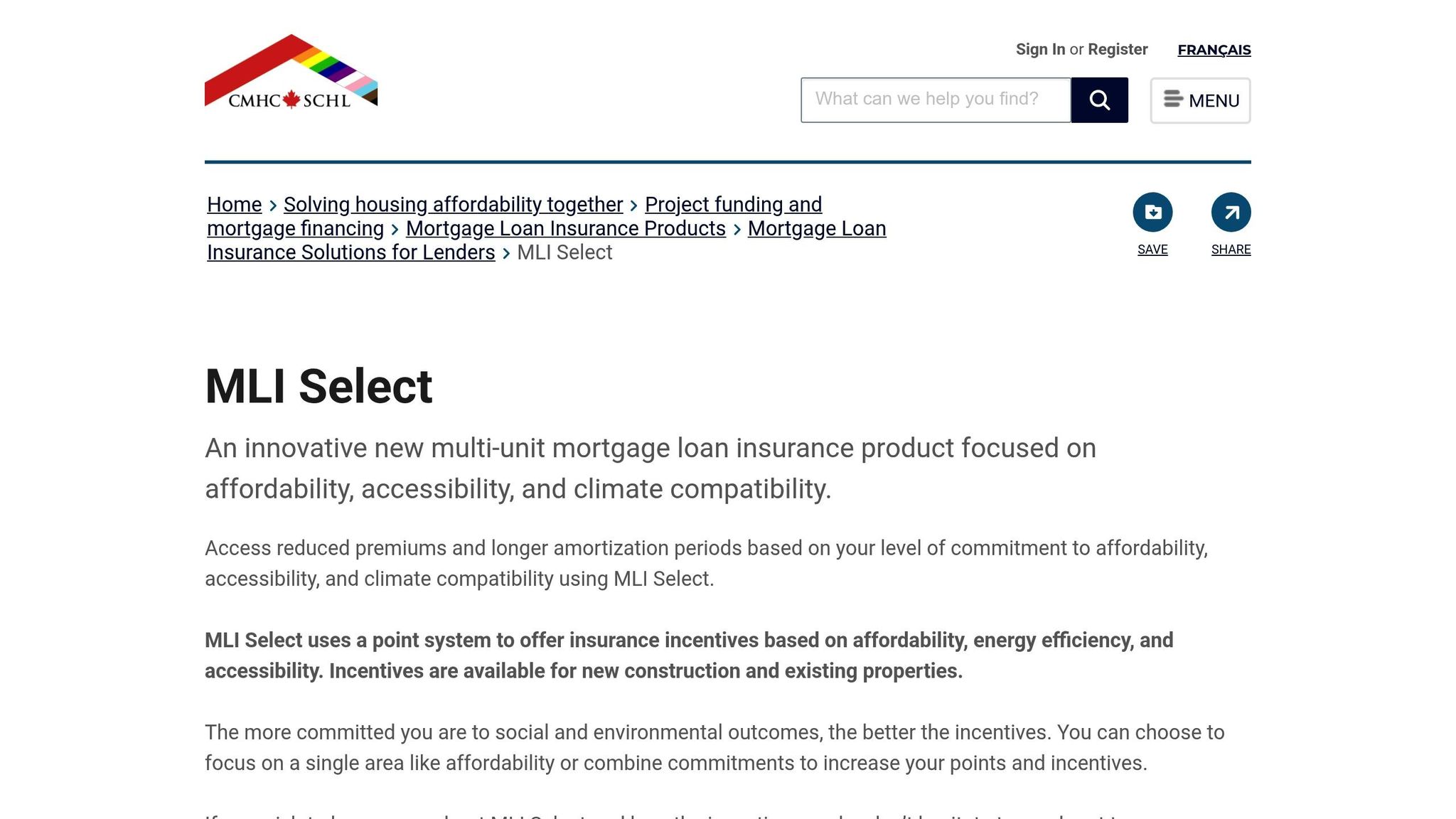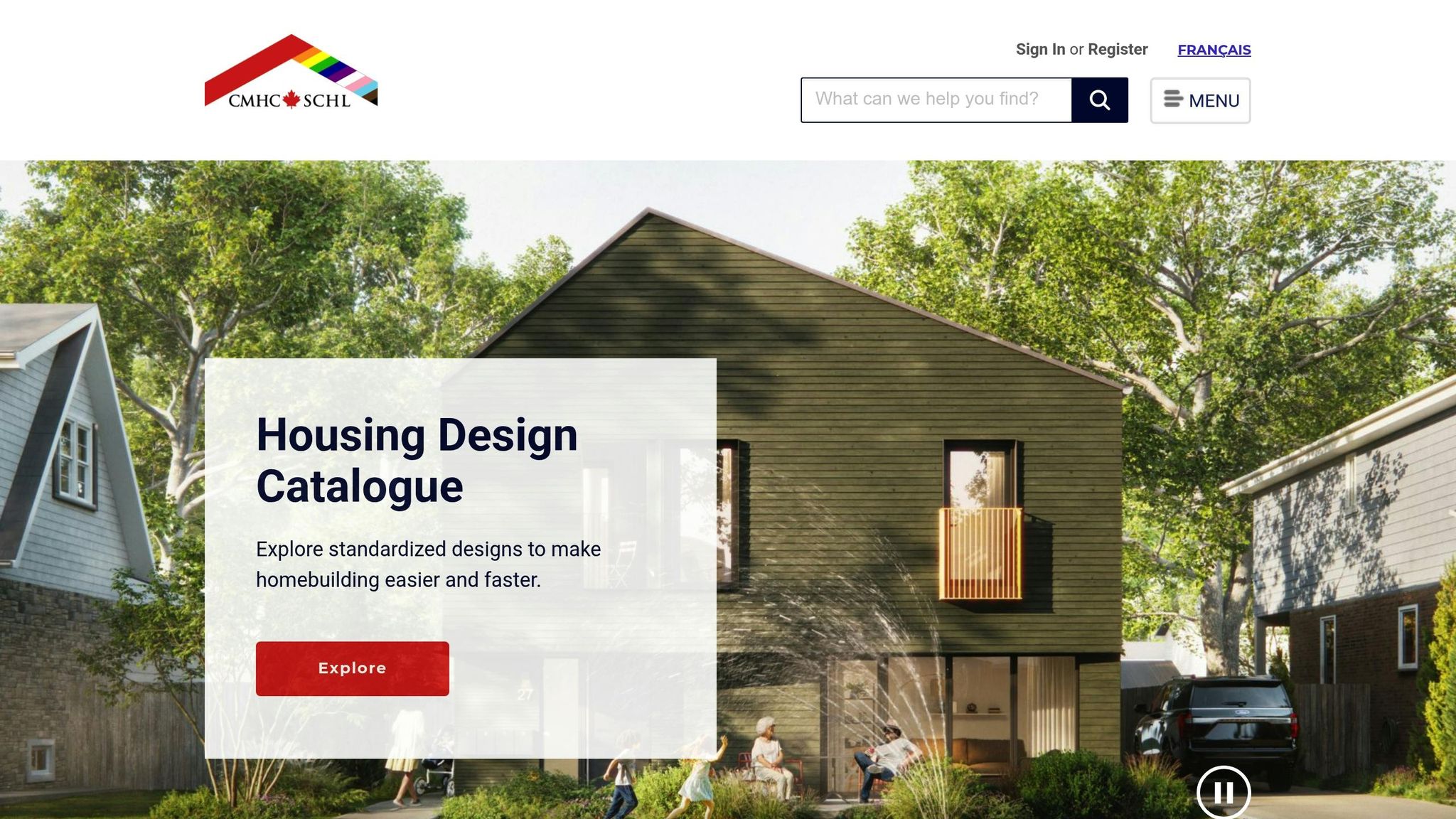The CMHC MLI Select plan aids Halifax builders in getting good loan terms to build rental homes, with a focus on cheap rent, saving energy, and easy access. Banks look first at things like how low the rent is (checked against Halifax's middle rent income), need in the market, and if the project can work well. Builders need to show clear plans, real budgets, and prove they can manage properties well. Teams that handle everything in construction can make things easier, lessen risks, and fit what banks want well. To win, you must match your work with what the plan wants and turn in a full, fact-backed form.
The REAL key to CMHC MLI Select - construction financing

What Lenders Look at First in CMHC MLI Select Forms

When lenders check your CMHC MLI Select form, they use a system that gives out points. You get more points for better loan terms. A key part of this check looks at how you meet price needs, checked against the middle earning of renters in Halifax. If there's no local news, lenders might use numbers from areas like it or average figures from the province [1].
Here's more on how they count points for price needs.
Price Needs
Price plays a big part in the MLI Select plan. Lenders give points for how many homes in your project have low rent. They use the middle earning of renters in Halifax to set the mark [1].
The point system helps homes that keep more units at low rent. For builds new to this with a promise to keep rents low for 10 years, here’s how points add up:
| Low Rent - How Long It Stays Low (10 years promise) | Points (Building New Homes) |
|---|---|
| 10% of homes at 30% of middle rent pay | 50 points |
| 15% of homes at 30% of middle rent pay | 70 points |
| 25% of homes at 30% of middle rent pay | 100 points |
To get the full 100 points in this part, you need to set 25% of your homes to cost 30% of what most renters in Halifax pay. For example, in a place with 12 homes, if three homes are priced at this lower rate, you will reach the top score.
Banks also give more points to plans that keep prices low for a longer time. While you must do this for at least 10 years, making it 20 years gives you 30 more points [1]. This can make your plan stand out more.
How Banks Look at the Safety and Payback of Your Project
When you ask for money to help with your multi-home build in Halifax's strong rent space, banks want to know if your plan is both workable and will make money. They look at many key points, such as market info, budget plans, and risk control steps, to see if your plan fits their needs. Here is a deeper look at how these parts shape their choice.
Studying the Market and Future Rents
Banks need a deep look at the market to show there's a need for rentals in your part of Halifax. To make your case strong, use trusted local figures - like empty home rates and how much alike homes rent for - that back your rent guesses.
Who lives there also matters a lot in this study. Point out things like more jobs in the area, easy ways to move around, and big places of work close by like Dalhousie University or the Halifax Shipyard. These bits help show long-lasting rent need. Make sure your rent guesses match what's now going on in the market; very high hopes with no strong proof can worry banks.
Looking at the Build Budget and Extra Money
A good budget for the build is key to showing your project can work. Banks will look closely at every cost, such as what you pay for materials, workers, permits, and other fees like designs. They will likely line up your budget with common costs for similar builds in Halifax. If your money guesses seem too low, banks may wonder if you've planned for all costs.
Extra money is also very key. This money covers costs you didn't see coming, like site issues, delays, or prices for materials going up, and makes banks feel sure that the project can handle money shocks. Also, banks will check if your money plans can take on construction payments, interest during the build, and other costs until the place is full of people living there.
Steps to Keep Risks Low
To keep risks low, banks often put safety steps in their loan deals, like those in CMHC MLI Select. For example, they might hold back part of the loan until the property fills up to a set level for a while, making sure the project does as hoped before they give all the money.
Banks may also have goals for how fast the building should fill up after it's ready to be lived in. If these goals aren't met, the loan details might change, or you might need to add more of your own money.
Insurance is another must-have. Builder’s risk insurance looks after the build phase, while general and property insurance look after the running phase. These plans often list the bank as an extra covered party. Plus, funding might be linked to key build times. Missing these times could mean more checks, changes to money terms, or the need for more of your own money. In some cases, banks may also want personal promises to make sure you are all-in on making the project work.
Money Rules and Paperwork for Loan Seekers
When you want CMHC MLI Select money help, it's key to know a lot about managing property. Lenders want to see proof that you have done well with homes that many families live in. This means you have taken care of lots of different homes and dealt with tough renter issues. Showing that you have this know-how makes lenders trust you more to manage lots of rent homes well.
How to Show You Know Property Management
Having good past work in managing property can make your request for a loan much better. To help show this, you should give detailed papers such as:
- Lists of homes you rented before and now, including how full they were and the money made from rent.
- Times when you handled many kinds of homes and fixed hard issues with renters.
If you haven't managed property much, think about working with a team that has lots of experience. Teaming up can cover where you lack in experience. When you show a full history of good management in documents, you make lenders feel safer that you can handle owning homes for multiple families. A strong record of managing not just checks a box for lenders but also helps keep things running smoothly, more so when you pair it with a smart plan for building.
sbb-itb-16b8a48
How All-in-One Construction Fits Lender Needs
Lenders fear risks like cost hikes, delays, and bad work - usual pains in old-style building with many teams and deals. All-in-one construction faces these troubles by putting all pros - designers, engineers, and builders - under one roof. Instead of dealing with six different firms, property owners work with one group that handles every part of the project. Here’s how this method lines up with lender needs through smooth ways and sure deals.
One Contact and Clear Ways
Lenders like clear steps and who does what in any task. All-in-one building makes things easy by using one firm to manage all from start to end. This cuts out the mix-ups and blame seen in old ways. With leaders right there to look at costs and line up jobs, lenders can be sure of steady and true watching.
On top of that, property owners can dodge extra costs. For example, using all-in-one builders can save about $47,000 per task by less need to line things up - helping keep money plans safe.
Set Prices and Sure Times
Going over budget is a big worry in big building jobs. Old ways, which often use pay-more-if-costs-rise deals, can push budgets up by 30–60%. All-in-one building skips this trap with set-price contracts and strict time vows. Some builders even put cash fines - up to $1,000 a day - for being late, making sure duties and on-time end. With all parts of the work run in-house, these promises are within reach, making the path much more sure for everyone.
Better Talks and Project End
Good talks is another plus of all-in-one building. By handling all project info through one talk system, the chance of wrong messages between teams is nearly gone. Property owners get regular photo news, and lenders hear about how things are going with steady update notes.
This smooth talk also helps spot and fix possible troubles early in the design step, stopping big shocks later. Quality checks are key, with five checks by a Pro Engineer, a final check picked by the property owner, and a two-year promise on all work. These steps give lenders and property owners sure thoughts that the work will hit top marks.
For those wanting CMHC MLI Select money help, picking an all-in-one builder shows a smart move to handle risks. It not only makes the building path more sure but also eases lender worries right from the start, making the money path simpler.
How to Boost Your CMHC MLI Select Chances
Getting a yes for the CMHC MLI Select program is about more than just hitting the base needs. Lenders want full, deep plans that show good thinking, sharp risk handling, and real views. By zeroing in on the key parts, property folks can set up for a win. Here are ways to help make your form look better.
Getting More Points in Main Areas
The CMHC MLI Select program rates forms on low cost, how green they are, and how easy they are to use. Aim to go past the least needs in each part to stand out.
For being green, pick the right gear to up your score big. Think about putting in heat pumps, strong windows, and great stuff to keep heat in to boost green points by up to 40%. To back these moves, lenders often need a pro energy report that shows how well your place does on saving energy.
Low cost is key too. Lenders will weigh your rent fees against the middle market fees. Keeping rents at or under 90% of the middle market fee can help your form. Use deep local market checks and on-point rent views to make your low-cost point strong.
For ease of use, going past the simple rules can add value. Things like wide doors, no-step entries, and usable baths not only lift your score but also show you care about the long-term needs of folks living there and what the market wants.
Teaming up with Builders Who Know CMHC Work
A strong form also leans on working with builders who get CMHC rules. Builders who've worked with CMHC know what papers are needed, such as deep build budgets, real time plans, and green performance numbers. This know-how helps dodge common snags like mix-ups, surprise costs, and hold-ups.
Firms that handle design, engineering, and building all together are extra good. These groups keep design, planning, and green checks in line. For instance, some builders have CMHC MLI Select build deals priced at about $200,000 per unit. While this costs more than the usual $160,000 per unit, the pay terms - like lower first payments and better cash flow - may make the extra cost worth it.
Turning in a Full and Rich Form
A full, well-backed form is key for getting a yes. Missing papers or too high hopes can cause delays or a no. Make sure your pro forma uses real market info and true empty rates.
Your build budget should cover all costs tied to your site, city fees, and extras for unexpected stuff. Lenders also look for signs of strong place running skills. If you're new to this, think about joining with a team that knows their stuff and show their know-how in your form. Also, letters from builders backing your build costs and time plans can make your case even stronger.
Making Your CMHC MLI Select Project Work
To set up your CMHC MLI Select project, you need to line up your plans with what lenders want from the start. This means careful planning and putting the right team in place early.
Begin by putting together a team that meets all the tech and rules needs. Your builder should work with pros like Professional Engineers, Architects, CETs, or CEMs known by CMHC [2][1]. For getting the OK on access, make sure your team has an architect or a named access pro who can sign off on needed papers [3].
Energy saving is important in the design stage. Plan for things like heat pumps, top windows, and good cover to keep warmth at the start. Adding these parts later is costlier and less effective. By getting your architect and engineer to work together early, you can make a system that saves energy and cuts down costs.
Having a good money plan is just as key. Your budget needs to be spot on and real since lenders will check every cost and see if it matches market rates. Sketchy or loose figures can make lenders unsure. To make your case stronger, work with builders who give you one price before you apply. This shows you're ready and tells lenders that surprises won’t mess up the project.
Full and clear papers are also vital for hitting CMHC MLI Select marks. Lenders look for detailed, numbers-based proposals. For example, your market study should have real rent numbers from the same kind of buildings nearby. A well-made pro forma needs to show real empty room rates - often 3-5% for Halifax big houses - and cover specific costs and city fees, which can be a lot.
It's smart to choose builders who know how to handle CMHC demands. The process has clear needs for costs, timing, and showing you meet the rules. Builders who know CMHC ways can help dodge common problems that might hold up approvals or cause rejections.
At the end, every choice - from your design moves to your money plan - should come together to show your project in a strong light. A smooth application shows off your project's chance to give affordable, saving housing and fits with what CMHC aims for.
FAQs
What should Halifax builders look at to meet CMHC MLI Select needs and get good loan terms?
For good loan terms under CMHC MLI Select, Halifax builders need to care for three key things: affordability, energy use, and project chance. Try to set at least 80% of your rental homes at or below the 30th percentile of local market rents. Also, keep non-home space under 30% of the total big floor area in the building.
Money lenders will need to see good money shape and true income. Hitting these marks not just helps you get approved but also helps get better money deals for your big rental work.
Why is an all-in-one construction way good for CMHC MLI Select works?
An all-in-one construction way makes it easy to handle CMHC MLI Select works by better joining up all involved. This way cuts down on wasting time, keeps hold-ups low, and helps control costs, making it easy to hit money lenders' needs for low costs, good use of energy, and the work plan as a whole.
By mixing tasks and putting all duty in one place, this plan gives land owners more clear leads and fewer changes. It stops the trouble of dealing with lots of deals and cuts down on wrong talks. The goal? A work that moves smooth and a higher shot at getting money help.
Do you need to know how to manage property to get money from the CMHC MLI Select program?
The CMHC MLI Select program does not say you must have experience in managing property to get a loan, but it could help you. If you've managed rental places before, lenders might trust you more to take care of a big property well.
If you don't have this kind of experience, don't stress - you can still show your strength in other ways. Talk up your team’s skills, bring up a solid property management ally, or lay out a clear and strong plan for your project. Also, stressing important points like cost-saving, using less energy, and the job’s overall do-ability can impress lenders. These steps can make up for not having direct experience in managing properties.



